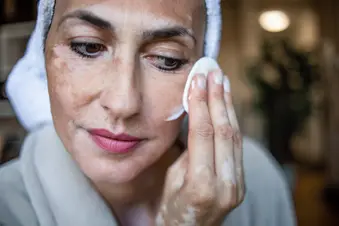
By Nada M. Elbuluk, MD, as told to Susan Bernstein
One of the most challenging aspects of generalized vitiligo is how much it will progress. This is different for each person. People who are newly diagnosed often ask: "How much will it spread or how stable will it be?" Some people may have stable disease for years. But others may have vitiligo that spreads at any point in their lifetime. If you’re on treatment, this can help your condition stay stable. If not, you can develop new patches.
[Choosing to camouflage vitiligo] is a very personal decision. Each person with vitiligo handles this differently. Some people want to conceal it. Other people are more comfortable with the way their skin looks and they don’t want to wear makeup. First, we will have a conversation about camouflage. I want to know how you feel emotionally about your skin’s appearance. I may also ask, "Do you want to begin treatment, or have your treatments not responded?" There are makeup products for vitiligo that you can acquire over the counter. Some people also use self-tanners that help to camouflage the areas of skin.
I also direct people to different support resources that are available, such as the Global Vitiligo Foundation. They have a section on their website about support resources for patients with vitiligo, as well as support groups across the nation. It may help you manage your feelings to meet with other people who also have vitiligo. Talking with others in a support group can be a very supportive, positive experience. There are online support groups for vitiligo, too. I try to suggest credible sources of information online.
Emotional Impact of Skin Color Changes
Research has conclusively shown that you can have a profound psychosocial and emotional impact from vitiligo. For one, you no longer feel that you have control over how you look -- how your skin appears. Vitiligo changes your skin’s color, and you may develop white patches anywhere on your body, including your face. There is also a great deal of variability in vitiligo and how extensive it is on your body. People also feel uncertain about their vitiligo’s progress: Will I have a flare? Will these patches get bigger?
Vitiligo can affect people of all skin colors. I have patients of all colors. We see it in both
adults and children. It can first appear earlier in life, but it can develop when you’re an adult. For children, it can be difficult to understand what is happening to them, and it can also be difficult for other children they are around to understand it.
Therapy and support groups for people living with vitiligo can be very helpful. It depends on the degree to which you are affected, but seeing a psychologist or psychiatrist can be helpful, too. We encourage any individual who is feeling any negative emotions to seek medical care.
Famous Role Models Decrease Stigma
Winnie Harlow was one of the first people with vitiligo to be public about it in a proud way. She is beautiful and a successful model, and she often models without using makeup to cover her vitiligo. This has helped decrease the stigma of vitiligo. There has been a positive wave in recent years about self-acceptance in general. People are starting to accept beauty in all forms which is so important. CoverGirl also recently selected their first spokesmodel with vitiligo. Mattel released a Barbie doll with vitiligo. You are seeing retail stores and marketing campaigns using models with vitiligo.
Self-acceptance of your vitiligo doesn’t take away the need to have treatment options for those who want them. But everyone should know that they are beautiful and have self-worth. It’s important to educate our society about vitiligo. People may ask you if it is contagious -- it is not. My patients also ask if it is hereditary. While there is a genetic and hereditary component to vitiligo, the chances of it occurring in the next generation is low. There is less than a 10% chance that you will pass it down to your children.
Protect Your Skin From Sun Exposure
If you are not treating it and just choose to live with your vitiligo as is, then you may not need to see your dermatologist regularly. If you are on treatment, or if you have vitiligo that is spreading quickly, then usually, you should see a board-certified dermatologist every couple of months just to monitor your condition and any changes.
My message to anyone who questions if they have vitiligo or if they’ve been diagnosed with vitiligo is to see a board-certified dermatologist, particularly one who specializes in vitiligo treatment. Again, it is completely up to each person if they want to seek treatment for it or not. Your dermatologist can guide you and talk you through all of your options.
If you have vitiligo, you should wear a sunscreen of 30 SPF or higher and a physical blocker of at least 8% zinc oxide, just as we would recommend to anyone. We used to worry that people with vitiligo were at increased risk of skin cancer. However, with more research, we have found that this is not the case, and in fact, you’re at lower risk of melanoma. Still, we recommend sunscreen as a general precaution, and if you’re out in the sun all day, reapply it every 2 hours.
Show Sources
Photo Credit: Milan Markovic / Getty Images
SOURCE:
Nada M. Elbuluk, MD, associate professor of clinical dermatology and director, Skin of Color and Pigmentary Disorders Program, Keck School of Medicine, University of Southern California.